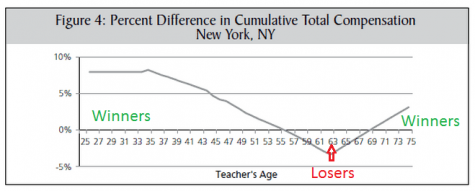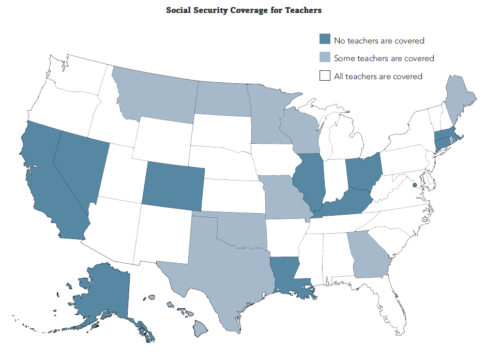Building upon the work of Costrell and Podgursky, University of Arkansas alums, Josh McGee and Marcus Winters, have a fascinating report out on how teacher retirement plans could be restructured in a cost-neutral way that would:
*Raise teacher salaries, in some cases substantially;
*Give teachers more retirement security than they now have;
*Make teaching a more attractive option for people who are unsure that they will work for decades in the same school district; and
*Offer teachers more control over when they stop working.
Of course, there is no such thing as a free lunch, but McGee and Winters have found something close. The current system of back-loading teacher compensation to provide large pension benefits only to teachers who remain in their profession in the same state transfers wealth from more mobile or short-term teachers. Smoothing out the spike in pension wealth and making some shift from deferred to current compensation would produce the benefits described above. Some teachers might lose but the vast majority would come out ahead. And the resulting system would be simpler, fairer, and more likely to attract quality people to teaching.
Here’s how McGee and Winters put it:
This paper examined the effect of cost-neutral changes to the structure of teacher compensation that, compared to current practices, would both increase teacher take-home salaries and offer a more secure retirement savings path for the majority of teachers.
Those who support the traditional DB pension systems that predominate across U.S. public schools correctly argue that such systems offer teachers a higher potential maximum retirement wealth than can be achieved under a cost equivalent smooth accrual system. However, our analysis makes clear that the higher maximum offered by the current system comes at a cost to a large share—often the heavy majority—of the teaching workforce: those who do not remain in their school systems for some three decades to become eligible for the maximum payout. In fact, these plans are explicitly designed to pay higher retirement benefits to long-career employees by reallocating wealth from teachers who exit the system earlier in their careers. As the detailed results for each of the 10 largest school systems provided in the final section of this paper demonstrate, in many systems these plans anticipate that the vast majority of teachers will not remain employed long enough to benefit from the traditional DB. Some long-serving teachers do well, but overall, this policy harms teachers’ retirement security.
This paper has also demonstrated the effect on teacher salaries of rebalancing the proportions of compensation that go to current salary versus retirement benefits. Our results demonstrate that such a reform would substantially improve teacher take-home salaries in some major school systems (though not in others). Of course, teachers require adequate retirement wealth; however, the heavy investment in retirement—only acquired by those teachers who remain in the classroom until the plan’s arbitrary normal retirement eligibility threshold—has artificially reduced teacher salaries in many school systems. If offered the opportunity, many teachers would likely prefer a system in which they took home a larger portion of their compensation than they do today.
– Jay P. Greene





